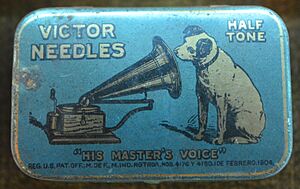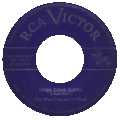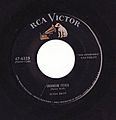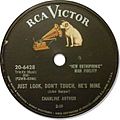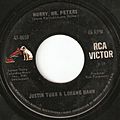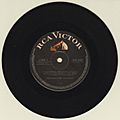RCA Records facts for kids
Quick facts for kids RCA Records Label |
|
|---|---|

RCA Logo introduced in 1968
|
|
| Parent company |
|
| Founded | January 9, 1900 (as Consolidated Talking Machine Company) |
| Founder |
|
| Distributor(s) |
|
| Genre | Various |
| Country of origin | United States |
| Location | New York City |
RCA Records is a famous American record label. It is owned by Sony Music Entertainment, which is part of Sony Corporation of America.
RCA Records is one of Sony Music's main labels. Other big labels include Columbia Records, Arista Records, and Epic Records. RCA Records has released many types of music over the years. These include pop, classical, rock, hip hop, afrobeat, electronic, R&B, blues, jazz, and country. The name "RCA" comes from its old parent company, the Radio Corporation of America.
In 1987, a company called Bertelsmann fully bought RCA Records. It became part of Bertelsmann Music Group (BMG). Later, in 2004, BMG and Sony merged to form Sony BMG Music Entertainment. In 2008, Sony took full control of RCA Records. RCA Records is also the company that continued the work of the Victor Talking Machine Company.
Contents
- The Start of RCA Records
- Making Records for Other Companies
- RCA and EMI
- World War II and Music
- After World War II
- The 1950s: New Sounds and Artists
- The 1960s: New Formats and Logos
- The 1970s: Quadraphonic Sound
- The 1980s: Changes and Success
- The 1990s: A Big Turnaround
- The 2000s: Mergers and Pop Success
- The 2010s: A New Era for RCA
- The 2020s: Recent Hits and Awards
- Broadway and Hollywood Music
- Other RCA Labels
- Gallery
- See also
The Start of RCA Records
In 1929, a company called the Radio Corporation of America (RCA) bought the Victor Talking Machine Company. At that time, Victor was the world's biggest maker of phonographs (like the famous "Victrola") and records. After this, the company became the RCA Victor Division of RCA. When RCA took over Victor, it also got the rights to the famous "Nipper"/"His Master's Voice" dog logo in the Americas.
In 1931, RCA Victor's British partner, the Gramophone Company, joined with the Columbia Graphophone Company to create EMI. This meant RCA's boss, David Sarnoff, got a seat on the EMI board.
In September 1931, RCA Victor introduced the first records that played at 331⁄3 rpm. They called these "Program Transcription" records. These records were different from the "LP" (long play) records that came out after World War II. This new format did not sell well. One reason was that the new record players needed to play these records were very expensive. They cost $395.00, which was a lot of money during the Great Depression. By 1933, RCA stopped making these records.
During the Great Depression, RCA Victor tried to make cheaper records. They wanted to compete with "dime store labels" like Perfect and Oriole. In 1932, they created Bluebird Records as a cheaper label. It started with 8-inch records. In 1933, Bluebird became a standard 10-inch label. The Bluebird label is still around today!
RCA Victor also made special recordings for radio stations called electrical transcriptions under the RCA Thesaurus label. These were not sold to the public. They were only for radio broadcasts. By the 1950s, these recordings included popular music by artists like Sammy Kaye and Lawrence Welk.
Making Records for Other Companies
Besides making its own records, RCA had a "Custom Record Division." This part of the company made records for many independent labels. RCA's factory in Indianapolis was a major spot for this. They notably pressed many record collections for The Reader's Digest Association.
RCA and EMI
RCA sold its share in EMI in 1938. But EMI kept selling RCA Victor records in the UK and other places using the HMV label until 1957. RCA also made and sold HMV records in North America.
World War II and Music
During World War II, RCA Victor's connection with its Japanese partner, Victor Company of Japan (Nippon Victor), was cut. JVC's record company is now called Victor Entertainment. It still uses the Nipper/His Master's Voice logo in Japan.
From 1942 to 1944, a big musicians' strike affected RCA Victor. Most union musicians in the US and Canada were not allowed to make recordings. This caused problems for record companies. RCA Victor lost the Philadelphia Orchestra during this time. The orchestra signed with Columbia Records instead. The Philadelphia Orchestra did not return to RCA until 1968.
After World War II
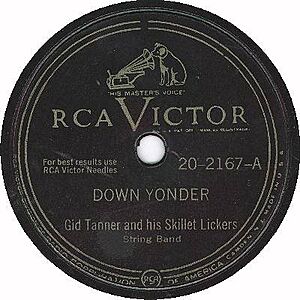
In 1946, "RCA Victor" became the main name on its record labels, replacing just "Victor." In 1949, RCA Victor introduced the 7-inch, 45 rpm vinyl record, called the "45." This new format was meant to replace the older 78 rpm records. However, it had a competitor: the 331⁄3 rpm "LP" (Long Play) discs from Columbia Records, which came out in 1948.
RCA Victor heavily promoted the 45s. They sold small, cheap players just for 45 rpm records. At first, RCA Victor's 45s came in different colors for different music types. Pop music was on black vinyl, classical on red, and country on green. This made production complicated, so they soon made all records black.
The first 45 rpm record made was "PeeWee the Piccolo" in December 1948. Vinyl was more expensive than the old shellac used for 78s. But because 45s were smaller and lighter, they actually cost less to make, store, and ship.
RCA Victor wanted the 45 to replace 78 rpm records. They also released "extended play" (EP) 45s that played for up to 7 minutes per side. They even sold boxed sets of 45s, which had about the same amount of music as one LP. Thanks to a huge advertising campaign, the 45 became the top choice for pop music singles by 1954. But Columbia's LP became the favorite for classical music and longer albums. RCA Victor finally started releasing LPs in January 1950.
The 1950s: New Sounds and Artists
Some of the first RCA Victor LPs released in 1950 included classical music by Arthur Fiedler and the Boston Pops Orchestra. RCA Victor used different codes for their records. "LM" was for classical LPs, and "LPM" was for non-classical LPs. When stereo records came out in 1958, "LSC" was for classical stereo, and "LSP" was for non-classical stereo. These codes were used until 1973.
In the 1950s, RCA Victor had a few smaller labels: Groove, Vik, and "X." Label "X" was announced in 1953. Groove was for R&B music, started in 1954.
RCA Victor and Columbia Records were big rivals in the 1940s and 1950s. RCA Victor recorded the NBC Symphony Orchestra with Arturo Toscanini. After Toscanini retired in 1954, the orchestra continued to record for RCA Victor as the Symphony of the Air. RCA Victor also recorded the Chicago Symphony Orchestra, the Boston Symphony Orchestra, and the Boston Pops.
In 1953, RCA Victor started experimenting with stereophonic sound. They made their first commercial stereo recordings in February 1954 with the Boston Symphony Orchestra. This began the practice of recording orchestras in both stereo and mono at the same time. These stereo recordings were first released on special reel-to-reel tapes in 1955. Then, starting in 1958, they came out on vinyl LPs with the "Living Stereo" logo. Many of these "Living Stereo" recordings are still available on CD today.
In 1955, RCA Victor bought the recording contract of Elvis Presley from Sun Records for $40,000. This was a huge amount of money back then! His first song for RCA Victor was "Heartbreak Hotel" in 1956. RCA sold ten million Presley singles in 1956 alone. Elvis Presley became RCA Victor's biggest selling artist.
In 1957, EMI/HMV ended its long partnership with RCA Victor. This happened because EMI bought Capitol Records. Decca Records then became the company that made and sold RCA Victor records in the United Kingdom. They used the RCA lightning bolt logo instead of the Nipper/His Master's Voice logo, which EMI owned in the UK. RCA started its own British manufacturing and distribution in 1969.
RCA Victor also released spoken word albums in the 1950s and 60s. These included soundtracks from films like Richard III and A Man for All Seasons.
The 1960s: New Formats and Logos
In 1960, RCA Victor tried to introduce "Compact 33" records. These were 7-inch records that played at 33 1/3 rpm, like LPs. The goal was to replace the 45 rpm disc, but they didn't sell well, and the idea failed by 1962.
In 1963, RCA Victor introduced Dynagroove. This used computer technology to try and make records sound better. Some people liked it, but others debated if it was truly an improvement. RCA stopped using Dynagroove by 1970.
In 1965, RCA and Lear Jet Corp. worked together to release the first stereo 8-track tape music cartridges. These "Stereo 8" tapes were first used in 1966 Ford cars and were very popular in the late 1960s and 1970s.
In late 1968, RCA changed its logo to a new, modern-looking design. They stopped using the old lightning bolt logo and the Nipper/His Master's Voice trademark. The Radio Corporation of America officially changed its name to the RCA Corporation. The RCA Victor Division was now called RCA Records. The "Victor" name only appeared on the labels of RCA's popular record releases. The labels of RCA Victor pop records changed from black to bright orange or yellow. The Nipper/His Master's Voice logo was only used on the covers of RCA Red Seal Records (classical music).
In late 1969, RCA Records introduced a very thin, flexible vinyl LP record called Dynaflex. RCA claimed these thin records would not warp as easily as thicker ones. However, some record collectors called them "Dynawarp" because they still had problems. RCA stopped making Dynaflex records by the late 1970s.
The 1970s: Quadraphonic Sound
In April 1970, RCA Records announced the first quadraphonic 4-channel 8-track tape cartridges, called "Quad-8." RCA also started releasing quadraphonic vinyl records in the United States in 1973. These used the CD-4 format, which RCA called "Quadradisc." This format needed special equipment to play the four separate sound channels. Columbia Records had its own quadraphonic system called SQ. However, quadraphonic sound never became very popular. Both RCA and CBS/Columbia stopped making quadraphonic recordings in 1976.
In 1975, RCA worked with Victor Company of Japan to create a Japanese record label called RVC.
In mid-1976, the RCA Corporation brought back the Nipper/His Master's Voice trademark. RCA Records put Nipper back on most of its record labels (like Victor, Victrola, Red Seal) and returned to the traditional black label color for pop releases. Nipper was once again widely used in RCA advertisements and on promotional items like T-shirts and coffee mugs.
The 1980s: Changes and Success
In 1983, Bertelsmann, the owner of Arista Records, bought 50% of RCA. In 1985, Bertelsmann and RCA Records formed a joint company called RCA/Ariola International. The next year, General Electric (GE) bought RCA Corporation. GE then sold its share in RCA Records to Bertelsmann. In 1987, the company was renamed BMG Music (Bertelsmann Music Group). BMG brought back the old RCA "lightning bolt" logo. They also brought back the "RCA Victor" label for classical music, Broadway shows, and movie soundtracks.
In the mid-1980s, RCA Records was losing money. In 1986, they lost $35 million. To fix this, they changed how the company was run. They cut the number of artists from about 40 to 11. They focused on finding new artists, including those from other labels like Beggars Banquet Records and Jive Records.
By the end of 1988, RCA Records made $236 million in the United States, which was their most profitable year yet. The album The Way It Is by Bruce Hornsby and the Range sold over three million copies. The soundtrack for the film Dirty Dancing sold 15.6 million copies in less than two years. Famous artists for RCA Records in the 1980s included the Eurythmics, Rick Astley, and Dolly Parton.
The 1990s: A Big Turnaround
In 1990, Joe Galante became the new president of RCA Records. He had been in charge of the Nashville division. The artist list was cut again, and the A&R (Artists and Repertoire) department was changed. Even with new efforts, RCA was not very successful in 1995, ranking 10th in market share. Galante went back to the Nashville division.
In March 1995, Bob Jamieson became the new president. He made big changes at RCA, removing some management layers and improving the marketing department. The A&R department was changed again, and the artist list was cut.
By the end of the 1990s, RCA Records had a "remarkable turnaround." This was thanks to successful artists like Britney Spears, the Dave Matthews Band, Christina Aguilera, NSYNC, and Foo Fighters. A deal with Loud Records brought hit songs from urban artists like Big Punisher and Wu-Tang Clan.
The 2000s: Mergers and Pop Success
In 2002, BMG fully bought J Records, a company it had started in 2000. Clive Davis was then put in charge of RCA Records and J Records, under a new group called the RCA Music Group. In 2004, Sony and BMG combined their music divisions to create Sony BMG. In 2007, the RCA Music Group was renamed the BMG Label Group. In 2006, Sony BMG merged its Broadway and classical music labels, including Red Seal, into Sony Masterworks. Legacy Recordings, Sony Music Entertainment's catalog division, reissued classic albums from RCA.
In 2008, Barry Weiss became chairman of the BMG Label Group. Later that year, Sony bought BMG's share. The BMG Label Group merged with the Jive Label Group to form the RCA/Jive Label Group. This group included RCA, Jive, J, Arista, and other labels.
During this decade, RCA Records had great success with pop music. Artists like Christina Aguilera, Kesha, Pink, Kelly Clarkson, and Pitbull had many #1 hits on the Billboard Hot 100 charts.
The 2010s: A New Era for RCA
In May 2011, Doug Morris became chairman of Sony Music Entertainment. He focused on A&R and named Peter Edge as chairman and CEO of RCA Music Group. Tom Corson became president. On October 7, 2011, the Jive, Arista, and J labels were all merged into RCA. The RCA Music Group was then ended, and RCA became a standalone label under Sony Music. Many artists from the merged labels moved to RCA.
In the first half of the 2010s, RCA released many platinum and multi-platinum records. These were by artists like A$AP Rocky, Chris Brown, Miley Cyrus, Kelly Clarkson, Foo Fighters, Alicia Keys, Kings of Leon, Pentatonix, P!nk, Pitbull, Shakira, Sia, Britney Spears, and Justin Timberlake. Since 2012, the label has released music by artists such as Kevin Abstract, Becky G, Bleachers, Brockhampton, Childish Gambino, Martin Garrix, H.E.R., Normani, Khalid, Kygo, Tate McRae, Mark Ronson, Sasha Sloan, Jazmine Sullivan, and SZA.
In 2015, RCA Records brought back its 1968 space-age 'RCA' logo. The lightning bolt logo is still used by RCA's Nashville division.
In January 2018, John Fleckenstein and Joe Riccitelli became co-presidents of RCA Records. Later that year, Keith Naftaly became president of A&R, and Tunji Balogun became executive VP of A&R.
The 2020s: Recent Hits and Awards
In 2020, RCA released successful albums by Bryson Tiller, Alicia Keys, Fousheé', and Pentatonix. They also had #1 songs like Doja Cat's "Say So" (with Nicki Minaj), Miley Cyrus' "Plastic Hearts", and Chris Brown & Young Thug's "Go Crazy". Brockhampton's song "Sugar" was certified platinum. Doja Cat and Kaytranada received many Grammy nominations. H.E.R. got her 13th Grammy nomination, and The Strokes' album The New Abnormal won Best Rock Album. Koffee signed with RCA after she became the first woman and youngest person to win the Reggae Album of the Year Grammy. In June 2020, the label worked with the Human Rights Campaign for a Pride Benefit Concert to support LGBTQ equality. SZA released the song "Good Days" in December.
In January 2021, Mark Pitts became president of RCA Records, and John Fleckenstein became chief operating officer. Jazmine Sullivan's Heaux Tales reached #1 on the Billboard R&B albums chart. Tate McRae's "You Broke Me First" was certified quadruple platinum in Ireland and double platinum in Canada, Mexico, and New Zealand. She was #1 on the Billboard emerging artist chart. In April 2024, Variety announced that RCA had signed Thai rapper Lisa from the South Korean girl group Blackpink for her solo work in America.
Broadway and Hollywood Music
RCA Victor has produced many famous Broadway cast albums. These include the original recordings of Brigadoon, Paint Your Wagon, Mary Martin's Peter Pan, Damn Yankees, Hello, Dolly!, Oliver!, and Fiddler on the Roof. RCA also recorded new versions of musicals, like the 1966 revivals of Show Boat and Annie Get Your Gun.
RCA Victor also made film soundtrack albums for movies like Damn Yankees, South Pacific, Bye Bye Birdie, and The Sound of Music. The album from the 1965 film The Sound of Music is one of the best-selling soundtracks ever. RCA also released the original American cast album of Hair.
In 2006, Sony BMG combined its Broadway music labels, including RCA Victor, into the new Masterworks Broadway Records. Many of these recordings have been updated and reissued by Masterworks Broadway Records.
Other RCA Labels
- RCA Records (UK): This is part of Sony Music UK. It sells music from American and international Sony Music artists. It also signs UK and Irish artists like Paloma Faith and Little Mix.
- RCA Red Seal Records: This is RCA's classical music label. It is now part of Sony Masterworks.
- RCA Records (France): This is part of Sony Music France. It started as RCA Cinematre in 1978 and changed its name in 2006.
- RCA Records (Italy): This is part of Sony Music Italy. It started as RCA Italiana in 1949. It closed in 1987 but was restarted in 2006.
- RCA Victor: This was the old name for RCA Records until 1968. It is still used for electronic, rock, and soundtrack albums, like The Sound of Music soundtrack. In 1987, BMG brought back the RCA Victor name for classical, pop, and soundtrack releases.
- RCA Records (Australia): This is part of Sony Music Australia. It started in 1956 and began recording Australian artists in 1963.
- Bluebird Records: RCA Victor launched Bluebird in 1932. It was a cheaper label that released jazz, blues, and country music. Today, Bluebird mainly offers jazz releases and reissues of old jazz, swing, and pop songs.
- RCA Inspiration: This label mainly releases Urban contemporary gospel music. It replaced Verity Gospel Music Group in 2013.
Gallery
-
A 1950s Canadian 45 RPM RCA Victor label
See also
 In Spanish: RCA Records para niños
In Spanish: RCA Records para niños
- RCA Victrola
- RCA Studio B



